One of the most rumored games for years was a remake of the classic Final Fantasy VII that finally came to fruition with the release of Final Fantasy VII Remake in 2020. Rather than cover the entire game, this first entry instead focused solely on Midgar in a much more expansive version than before. Not only that, but the game also proved to be sort of a sequel in some ways rather than just a straight-up remake as a major part of the game was changing fate from the way things are meant to, meaning as it was in the original game. Having no real idea where the now-known-to-be trilogy would go from there has had fans anxiously awaiting the second entry and it delivers in pretty much every way imaginable now that it is finally here and we have had a chance to review the game ahead of release.
The World of Final Fantasy VII
I was a bit late to the Final Fantasy franchise back in the early 2000s as Kingdom Hearts was my gateway to the series, leading me to get Final Fantasy X and then Final Fantasy VIII as my first PS1-era game, followed by Final Fantasy VII and Final Fantasy IX. While all still hold a special place in my heart, Final Fantasy VII actually was my least favorite of the bunch overall, which is like saying one of your children is your least favorite of the bunch. I still adored the game, but I always found myself clicking with the others just a little bit more. When the series started branching out with the Compilation of Final Fantasy VII, I saw Advent Children and really enjoyed it, but missed out on playing games like Crisis Core and Dirge of Cerberus at the time.
Jumping forward many years later, Final Fantasy VII Remake came out and completely enthralled me from the opening moments and quickly became one of my favorites of the entire franchise, making me appreciate the original even more as well. Also getting a chance to play Crisis Core: Final Fantasy VII Reunion more recently, my expectations could now be higher for Final Fantasy VII Rebirth to see how they manage to take the story forward in an open-world setting beyond Midgar.
Final Fantasy VII Rebirth picks up immediately after the events of the expansion Intermission, where the group of Cloud, Tifa, Aerith, Barret, and Red XIII have now arrived in Kalm after leaving Midgar. While staying at the local inn, Cloud recounts his supposed backstory from five years prior in Nibelheim where Sephiroth and the green Cloud arrive to inspect the Mako reactor there. This was handled well with the jumping back and forth between past and present and any questions I had about why Tifa was not interjecting about some inconsistencies in the story were answered soon enough.
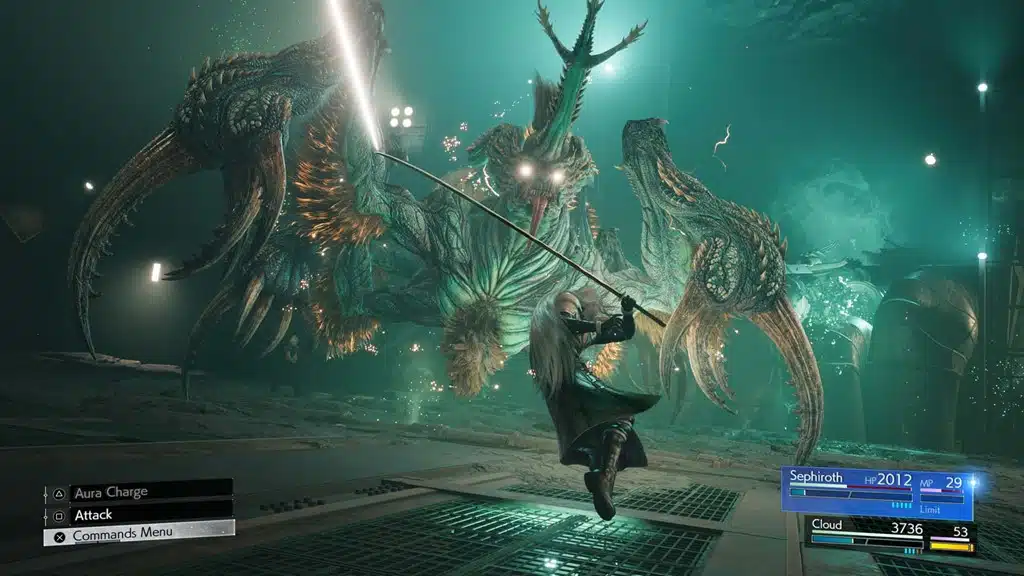
This opening sequence not only lets us play as Cloud but also gives us the first opportunity to play as the big baddie Sephiroth himself before he goes down the path of darkness. While playing Crisis Core beforehand definitely helped me to take more from this story in Nibelheim at the outset, Rebirth does a fantastic job at filling in players who had never played that game prior through these lengthy flashbacks.
Playing as Sephiroth isn’t that different from Cloud overall, though he does have a few special abilities that are exclusive to him that you can use in battle. These early battles also introduce a major new mechanic that plays a big part in the battles in Rebirth known as Synergy which will be discussed in depth during the battle system breakdown. It was really interesting to see this different side of Sephiroth when he was seen as a hero by everyone and how his descent into villainy feels natural rather than a quick flip of a switch due to his entire world being a lie.
After the story resumes in the present, the world of Final Fantasy VII Rebirth starts to open up with the city of Kalm and the Grasslands region surrounding it. The outline of the story from here follows a similar path to the original Final Fantasy VII where you visit major locations like Junon, Gongaga, the Gold Saucer, Cosmo Canyon, and more, though now they are much more fleshed out. Characters like Dio at the Gold Saucer and plenty more have much larger roles than in the past, adding even more life to this world that was already teeming with charm in the first place. Many of the more emotional moments like the introduction of Barret’s backstory and his best friend Dyne hit even harder this time with the ability to let the events breathe on their own, which never would have been possible without the way this game has been split into a trilogy.
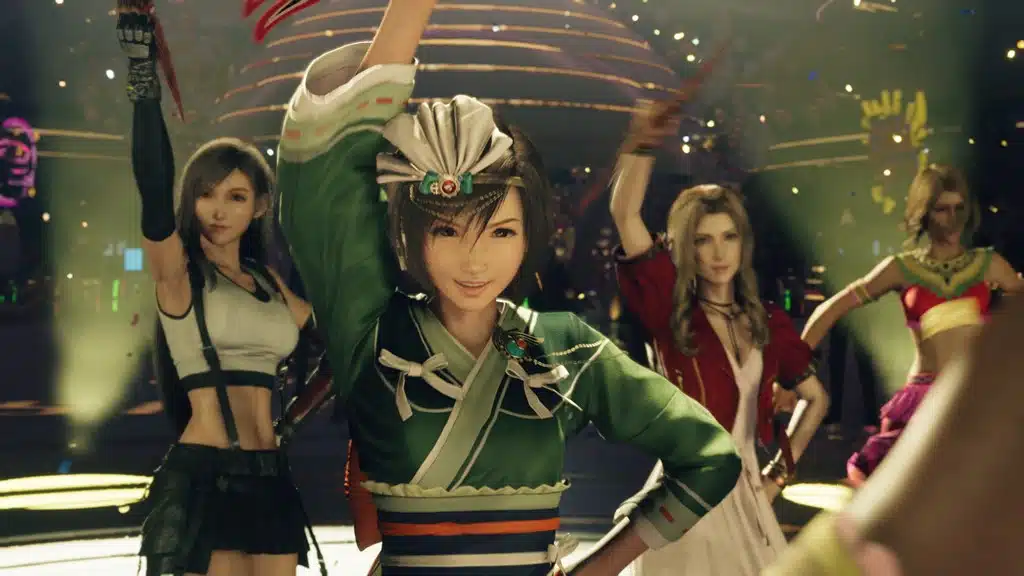
Diving any further into story details would be a disservice to the player, both those who played the original Final Fantasy VII and those who never have. There is plenty that is completely new, especially regarding the Whispers that played such a prominent role in Remake, so going into the experience as blind as possible is wise. This is definitely one of those games where you are going to want to play without getting online to read further before accidentally getting yourself spoiled on many of the best moments in the game. Numerous moments literally gave me goosebumps during my playthrough that were a mix of story moments, character interactions, and just the grand scale of some parts of the game itself.
Open It Up
After leaving Kalm for the first time, the open-world mechanics of the game come into play where you get to explore every nook and cranny of the large open-world environments starting with the Grasslands. The game is split into separate open-world locales that eventually become more connected as you get later in the game. Each region is full of intel for you to gather that is split into a number of different varieties. Chadley returns in Rebirth to guide you to these various intel, which are split into Activation Intel, Expedition Intel, Fiend Intel, Divine Intel, Excavation Intel, Moogle Intel, and Phenomenon Intel. A nice touch I really thought was neat was that Chadley’s interactions with you play the audio through the DualSense controller by default since he’s also talking to Cloud and company through a handheld device.
Activation Intel are towers that are found throughout each region that you can find and activate, which then add icons for the other types of nearby intel to the map. The towers themselves are already on the map, which serves as a good guide on how to branch out in each region. Upon first arriving in each region, there is a fog covering the entire map that you can clear by adventuring across the area. I was a little hesitant at first with the towers aspect since that has become such a trope found in open-world games like those from Ubisoft and even games like The Legend of Zelda: Breath of the Wild, but they are handled well here as a way of not clearing the fog over the map itself, but just giving you guidance on other intel to acquire nearby.
The Expedition Intel leads you to Mako lifesprings around the map that you must survey with a few timed presses of Triangle. I do wish these changed a bit in how they were scanned to set them apart in each region, but that’s a nitpick more than anything. Scanning the lifesprings can unlock Excavation Intel, which allows you to unearth recipes to transmute later and also eventually gain access to a tough battle. Not quite as difficult are the Fiend Intel that pit you against various enemies, but that is not all. You always have three tasks to complete, which typically are to pressure an enemy, stagger an enemy, and defeat the enemies in the allotted time, but these sometimes change. The nice thing here is that if you miss one of the tasks, you can retry immediately and not have to worry about obtaining the previously earned tasks from the prior battle again.

Summons play a big part in Final Fantasy as a franchise and they are still handled just as they were in Remake here battle-wise. The way of obtaining them is a little different though, as each region has a specific summon that you can fight as soon as you first run into Chadley for that region via the Combat Simulator. These battles are insanely difficult though and are synced to your level, but you can help yourself by finding the Divine Intel and completing the memorization puzzles. By finding the three intel in each region, you can face a weaker, yet still quite tough version of the summon and be rewarded with the summon Materia upon your victory.
Without question, my favorite of the Intel were the Phenonemon Intel that not only were a lot of fun and offered varying mini-games or tasks to complete, but also had a lot of great story elements that tie into the overarching narrative. Each region has four of these for you to find and complete, with you being rewarded with a protorelic for all of them. These protorelics then combine and lead you on a major sidequest that is well worth your time in the end. If you are going to take part in any of the Intel, the Phenonemon ones are the most important, though it was weird when a few of them could not be completed in the first run-through of a region.
Let’s Synergize!
What is a Final Fantasy game without combat? The general gameplay in Final Fantasy VII Rebirth is the same as it was in Remake, which makes it feel like a natural continuation of the previous game, albeit now with a fully playable Red XIII from the start as well. This includes the action role-playing style of battle where you press square to attack with each character’s corresponding weapon or hold it down in Barret’s case to shoot his arm cannon. The styles of combat change throughout the game as well as you get the new party members of Yuffie and Cait Sith, though those who played Intermission will already know how Yuffie plays. I am still very impressed by how distinctly different the development team managed to make each character to where each feels like it got the full love and care it deserved given to it. This is extremely important too, as there are many moments in the game where your team is split up and you are required to play as a certain team of characters or even a solo character, which could have gotten very frustrating if there were poorly designed ones.
As aforementioned, the major new feature in the combat for Rebirth is known as Synergy Abilities. By using the also new Folio system that serves as a skill tree that felt reminiscent of something like Final Fantasy X’s Sphere Grid and the like from other entries in the franchise, you can upgrade your character using SP that you earn, including unlocking Synergy Abilities between that character and another. It is vital to unlock numerous of these for the main characters that you use in battle, as you cannot use them in battle otherwise.
The way to gain access to a Synergy Ability in battle is for both characters that will be teaming up for the move need to use a certain number of Ablities or Spells that are marked just below their ATB bar. Once you reach the required amount of uses for each of the duo, you can go to the Synergy Abilities option in the Commands menu and select the corresponding one. Characters have more than just one with another character too, which comes into play since you cannot reuse the same Synergy Ability. Some of these are team-up attacks, some are more defensive, and the very useful United Refocus even lets you split your ATB bar into three parts for more readily available use of Abilities and Spells. Synergy Abilities can really turn the tide of battle and are great to use in tandem with other abilities to try and stagger enemies and then unleash your Limit Break for maximum damage.
The weapon and Materia systems are essentially the same as they were in Remake, though the Folios have not replaced the weapon-specific upgrades that used SP before for an overall character upgrade system instead. Each weapon still has a few abilities that you can set though, which allow you to mix and match your loadouts. There are plenty of new weapons, found throughout the game in distinct purple chests, though you can also purchase them from the weapon shop if you miss them out in the open. Each weapon also still comes with a learnable ability that you can add to your repertoire upon mastering. Doing this is very important, as you can get stellar abilities like Tifa’s Starshower to use anytime regardless of if you upgrade to a better weapon. If you are not using this ability, you are really making the game harder on yourself than it should be.
A key part of the equipment system is the new transmutation ability that you have available to you in the main menu. From here, you can use materials that you acquire in your travels to transmute into other objects, whether they are items, armor, or accessories. You have to continually raise your Craftsmanship level by transmuting more items, which will then unlock new options for you to use. You can also find new recipes as mentioned before with the use of a special friend that everyone knows, a Chocobo.
Arguably, the most iconic figure in the Final Fantasy series is the Chocobo, which has played a big part throughout the franchise. Due to being in Midgar for the entire first game, they were only there in the story and not as rideable characters. That changes drastically in Final Fantasy VII Rebirth with the much larger world to explore, where each region has its own distinct Chocobo with its own skillset that is vital to your traversal. All Chocobo can be ridden on and track scents to find items, but they also have special abilities beyond the basic one you start with.
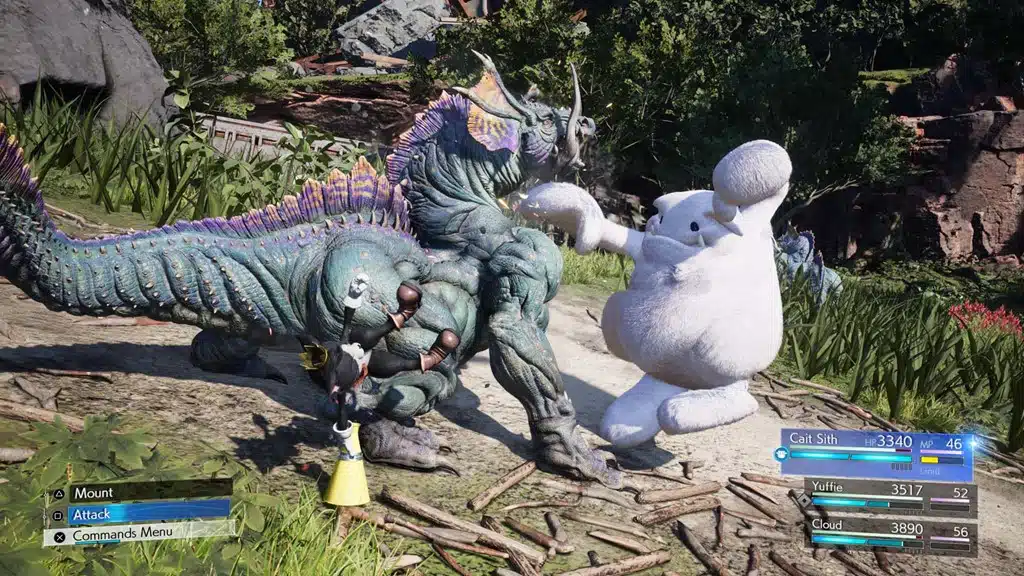
Starting with Junon’s Mountain Chocobos, which can scale the sides of certain cliff faces, and going all the way to my personal favorite, Nibel’s Ocean Chocobos, which essentially have water jetpacks, each of these are required to help you advance in the story as well as access a good portion of your sidequests. After gaining access to each region’s Chocobo, usually through a mini-game of wrangling the Chocobo, you can call upon it with the press of a button by using your whistle pretty much anywhere in that area. I did have to laugh when they would show up from behind out of nowhere, but it always felt absolutely seamless. It was also a nice touch that the game always has your full team together each on their own Chocobo following you as you ride too.
Not only do you have the large size Chocobos that you can ride, but you will also run across Chocobo chicks which means a Chocobo Stop is nearby. By following them and setting up the sign beside the stop, you can unlock a fast travel location on the map.
Chocobos aren’t the only method of transportation in the game though, as you have a few other options that are specific to regions and one later game option I will let you discover for yourself. As seen in the trailers before, you can ride around Costa Del Sol on the game’s equivalent of a Segway known as a Wheelie as soon as you enter the area. It’s really hard to beat playing as Cloud in his beachwear riding around the vacation resort on the Wheelie, which I spent a lot of time doing. This doesn’t help you do much besides save a little time going around the fairly small town, but it was just a blast to do so I did it whenever I had the opportunity.
Much more useful in the game is the Buggy that you unlock in the Corel region after you reach the desert. This large vehicle seats your entire team and lets you travel across plenty of areas not accessible otherwise in the desert. I was a bit hesitant at first due to similar vehicles in games of the past, but the controls for this were incredibly well designed to where you continually felt like you had full control and never worried about steering in the wrong direction or getting stuck. Like the Chocobos, you can call this from pretty much everywhere in the Corel Desert region as well with the press of a button.
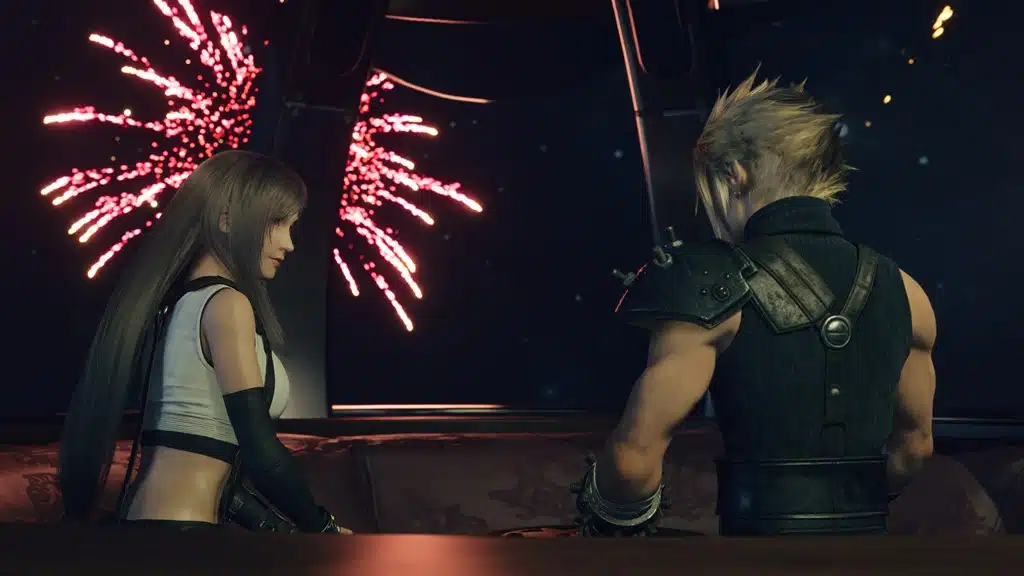
While Final Fantasy VII Remake had a semi-relationship feature that led to a “date” scene with one of Tifa, Aerith, or Barret in the flowers outside of Aerith’s house depending on decisions made in only a few areas, this is expanded upon greatly in Final Fantasy VII Rebirth. The game now has an actual relationship system built in based on your interactions with the different characters in your party that will eventually lead to Cloud going on a date with the corresponding character late in the game at the Gold Saucer like in the original Final Fantasy VII. When talking to one of your party members, pick the answers you think will be best suited to that character and you will get notifications about the relationship with said character changing or deepening. These moments are usually found when the team is split up in a town for you to explore and you can talk to them individually, each marked with an emoji-like smiley face that gauges their relationship with you.
Completing quests associated with each character also can greatly strengthen your relationship as well, though I found myself doing every quest I could find to where it was probably more of a wash there. The last way is by using Synergy Abilities between Cloud and the character you are trying to increase your relationship with. For me, Tifa got a huge boost for me as she was almost always in my party and often was used in Synergy Abilities with Cloud. This eventually led to her being Cloud’s date at the Gold Saucer, which was the one I felt was the best option based on their story together in the game. Character moments like this in the game that are just about the characters at their very emotional core hit in a way that few other games can match and keep you captivated to find out what is going to happen next.
While this worked out for me, one of the few aspects of the game that did not really work for me was the lack of being able to tell relationship levels with your party members beyond the surface level. As the game says, you can hold down L1 to see a character’s status based on a smiley face. However, this becomes an issue if you are raising relationship levels with all of your party members as I was doing by completing all quests that I could find. By the time I got later in the game where it mattered for the date, pretty much all of my characters had the highest level blue faces and I couldn’t tell which I needed to work on further. Even so, this feature is much more fully fledged than in Remake and was handled quite well minus this aspect of it.
A great quality-of-life feature added to this game that was missing in the first is the ability to set an active party leader within your party of three. Gone is the starting of every fight as Cloud and having to manually switch every time to another character if you prefer to lead with them. All you have to do is set your existing party in the menu and select who leads upon battle. You might think this would also affect who you walk around as in the game, but that is not quite the case.
As much as I love Cloud in this game yet again, I was disappointed that the main controllable character outside of battle is still Cloud most of the time. This is made even stranger by the fact that each of the other party members in the game each game at least one or more sequences where you control them for long periods of time in a section based on the story or specific quest, so they are clearly designed to be able to do so. These were actually some of my favorite parts of the game, whether it was Red XIII running up walls or Cait Sith rolling through ducts that only a small cat could manage to squeeze through. If there were some hidden items elsewhere in the overworld that required specific party setups, that would have been cool. The reason for being locked onto Cloud most of the time though is likely that it would be harder to have Cloud initiate discussions with the other party members for relationship purposes if he wasn’t in control, but I don’t see how having someone else be the controllable one would be that big of a deal when the whole party or most of it is together regardless.

After playing Final Fantasy VII Remake and seeing what they were able to do on PlayStation 4 and then seeing Intermission on PS5, it comes as no surprise that Final Fantasy VII Rebirth is a visually stunning experience. The facial animations and voice acting for the characters are really on another level and get you even more invested in each of these individual characters to where you feel their joy and pain as they go through each emotion. The environments are also gorgeous throughout, even with a little blurriness here and there, though thankfully nothing as bad as the infamous blurry door from Remake. Oddly enough, I noticed this more often around the secluded Chocobo Stops for some reason, but it’s rarely a problem.
Final Fantasy VII Rebirth allows players to choose between a graphical optimization or performance optimization, of which the game defaults to graphics. I never even had to change this, as I rarely noticed issues with the performance while playing. For a game of this scale, this was quite impressive to me, as I’ve witnessed my fair share of open-world slowdown over the years.
For a game as large as Rebirth, load times and fast travel also play very key roles. While you have the Chocobo and such to navigate the terrain, you can save a lot of time by fast traveling to the many icons on the map that include Chocobo Stops, Intel points, and other notable locations. As soon as you select the point to fast travel to, the game loads back up in a matter of a second or two, which is downright incredible. Having games like this and Marvel’s Spider-Man 2 that push the limits of scale while also not sacrificing by having load times is all the more impressive.
As one comes to expect with a Final Fantasy game, the entire soundtrack for Rebirth is absolutely stunning. Whether you know the music from the original or are having a fresh experience, the tracks here are phenomenal from start to finish. After getting to attend Final Fantasy: Distant Worlds two years ago, I have been waiting to finally hear the new version of Cosmo Canyon here and it made me giddy as soon as I heard it. One track that was a really nice surprise to hear was the inclusion of an instrumental version of “Hollow,” the end credits theme from Final Fantasy VII Remake. Making it even better is that it starts playing as you near the outside of Midgar within the Grasslands, which felt fitting.
Removed from Remake is the jukebox feature with the collectible discs for songs, but now it has been replaced with fewer songs playable via piano. You can find sheets of music in the game that you can then perform at the piano in a mini-game, which I found myself playing way too much. I have no doubt I’ll be coming back to the game just to play this in the future at times and hope more songs are added in the future.
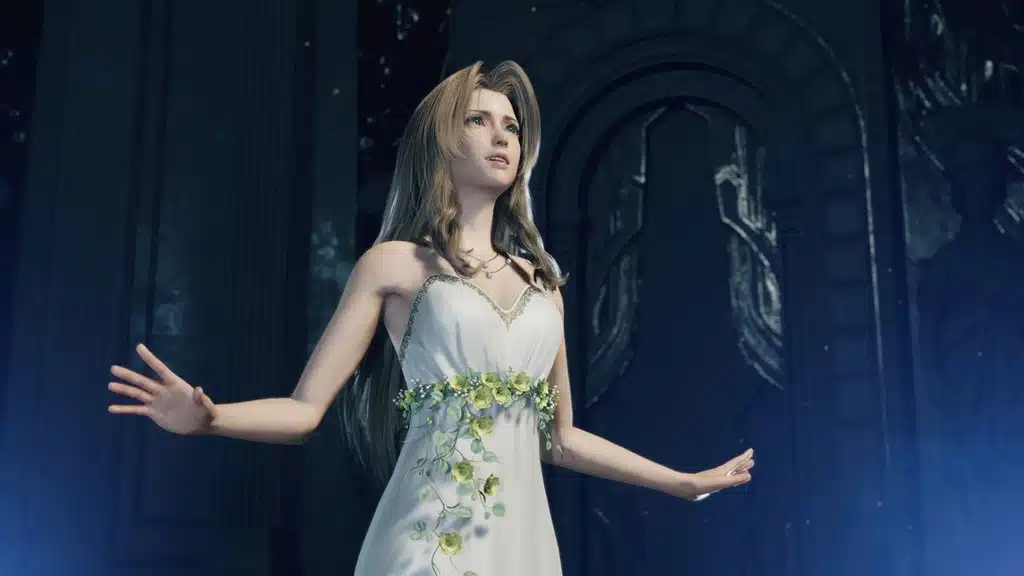
Final Fantasy VII Rebirth also has a ton of other mini-games to play, most of which are housed in the Gold Saucer or as part of the previously mentioned Phenemon Intel quests. The mini-games in the Gold Saucer range from Chocobo Racing, 3D Brawler, and more. The 3D Brawler does like Fort Condor did in the past, which also returns here as well, and utilizes the blocky PS1-like character models with the characters as an homage to the original Final Fantasy VII.
The most robust of the bunch though is the all-new card game known as Queen’s Blood that you can play there as well as all around the world as you find competitors. Similar to many other card games in the Final Fantasy series, your goal is to overwhelm your opponent using cards equipped with point denominations and abilities to where you come out on top. You can keep adding to your deck as you acquire new cards, but I actually found that it was better to stay simple than to get super complicated with the deck as time went on.
Verdict
Final Fantasy VII Rebirth is a game that I have been waiting to play as soon as the credits hit in Remake and then the Intermission expansion, but I never thought it would somehow be able to exceed my already high expectations. The game takes what is still content from disc 1 of the original game and manages to expand upon it in so many ways without screeching the pace to a halt and ruining the experience. Instead, it builds upon that world and breathes new life into it with a lengthy experience. My initial playthrough where I was completing most quests along the way exceeds 100 hours and there is still plenty more I need to go back and wrap up, which is a major uptick from the length of Remake itself. You can also just run through the main story if you prefer and complete it in much less time as well, as the game offers a chapter select upon completion for post-game cleanup and even a Hard Mode once again.
The gauntlet has already been thrown as a Game of the Year contender with Final Fantasy VII Rebirth and it’s going to take one hell of a game to match its quality in 2024. The expanded story is riveting from start to finish, serving as essentially the Empire Strikes Back of the trilogy. Even the smallest of sidequest can add something to the lore of the world or the overall narrative that you wouldn’t expect as well, which makes you want to complete everything the game has to offer. It is pretty amazing what Square Enix has managed to put together here with this Remake trilogy and I cannot wait to see how they build on Final Fantasy VII Rebirth for the third and final chapter in what is setting up to be one of the greatest gaming trilogies of all time.
Score: 10/10
Pros:
- Story and character interactions are even better than in Remake
- Open-world design works wonders
- New Synergy systems fits perfectly with the existing battle system
- Meaningful quests that are worth fulfilling
- Numerous quality-of-life improvements
- Visuals and music are stellar
Cons:
- Relationship gauge is not detailed enough
Final Fantasy VII Rebirth review code was provided by the publisher. You can read MP1st’s review and scoring policy right here.
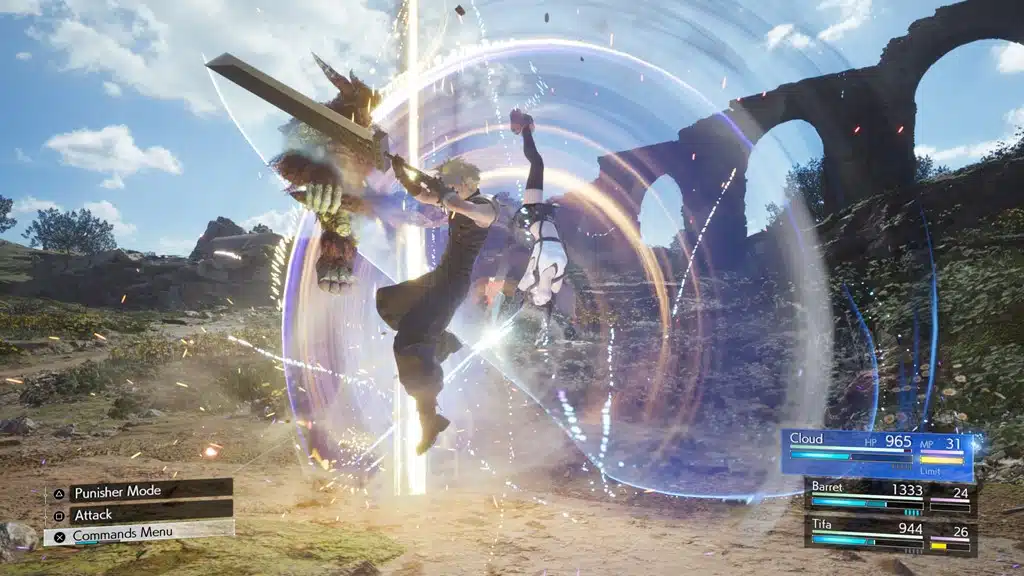
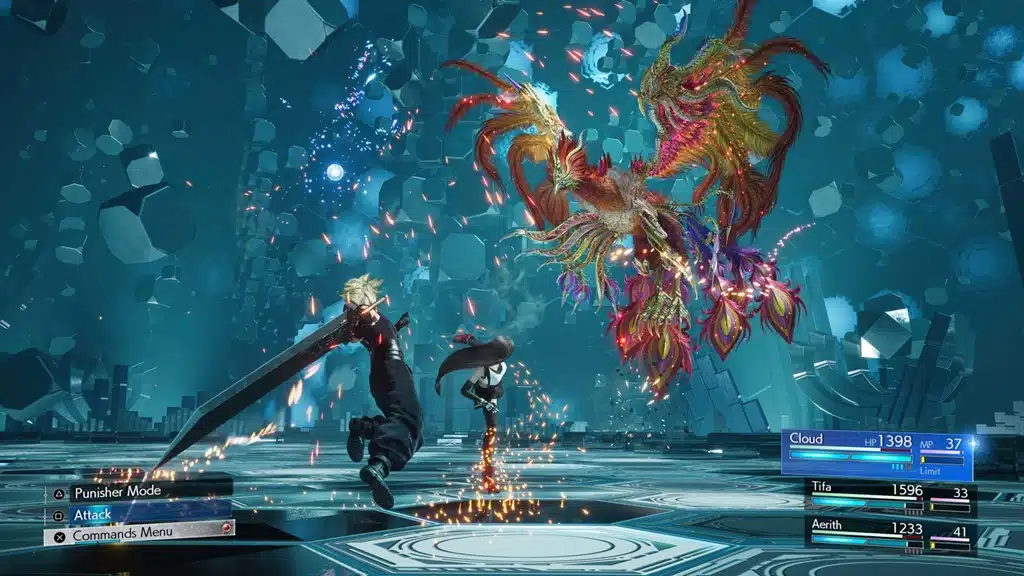
Most reviews i’ve seen are giving Final Fantasy 7 Rebirth a 9 or a 10, i’ll play regardless of what reviews say and form my own opinion.